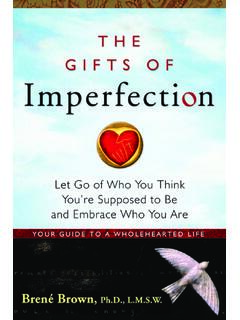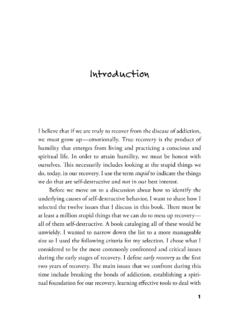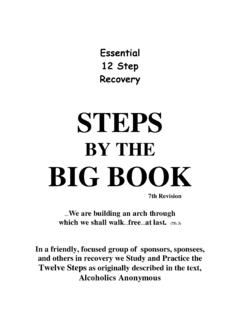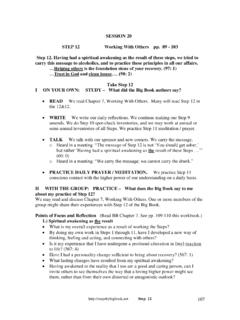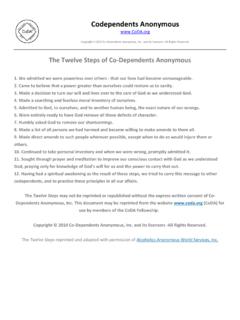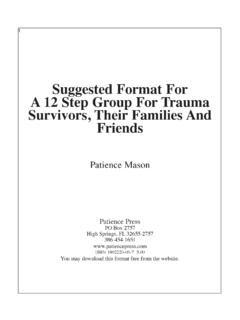Transcription of A Woman’s Way through the Twelve Steps - Hazelden
1 A woman s Way through the Twelve Steps Stephanie S. Covington, Contents Dedication Acknowledgments Special Acknowledgments Introduction The step Before the Steps step One step Two step Three step Four step Five step Six step Seven step Eight step Nine step Ten step Eleven step Twelve A step After Self Relationship Sexuality Spirituality The Twelve Steps of Alcoholics Anonymous Notes About the Author Introduction As a woman in a Twelve step recovery program, or as one who is beginning to think about recovery from addiction.
2 You may be thrilled to find a book that focuses on your issues as a woman in recovery. Or you may be wondering what this book offers that you have not found in other books or in Twelve step literature and meetings. through my own recovery from alcoholism and my professional and personal relationships with women in recovery from a variety of addictions, I have found that a number of issues unique to women are overlooked in most Twelve step programs. Some of these issues include the effects on women of the language of the Twelve Steps , the psychological development of women as it relates to addiction and recovery, and the social and cultural factors that affect us as women both in general as females in a male-dominated society and specifically as women living through addiction and recovery.
3 As a result of these omissions, many of us have struggled to stay with a recovery program that does not completely meet our needs or match our values. Others may have experienced relapse and felt that something was missing from their recovery program without being able to identify what that something was. My hope is that this book will offer you a new, more accessible perspective on recovery from addiction, one that acknowledges your needs and concerns as a woman . This new perspective is based on a more open exploration and a more flexible interpretation of the Twelve Steps as they relate to women in recovery.
4 It derives from the mutual learning that is possible among women as we share the stories of our struggles and triumphs in recovery. My hope is that this perspective will empower you to take ownership of your recovery process as well as your growth as a woman . The Twelve Steps were first developed in 1939 by the founders of Alcoholics Anonymous (AA). In the past fifty-five years, the Steps have been adopted by a variety of self-help groups and have provided an invaluable resource and guide for people on the recovery journey.
5 Millions have taken this journey, using the spiritual, emotional, and practical resources of the Twelve Steps in their recovery from alcoholism, drug dependency, eating disorders, sexual compulsions, gambling, and more. The history and tradition of the Twelve Steps provide a sense of security and certainty about their effectiveness. At the same time, it is important to recognize that the Steps were written by men for men s needs in recovery at a time when women had few resources and little social, political, or economic power.
6 At the time the Steps were written, the possibility of a woman becoming addicted was barely considered and women with addictions faced shunning and secrecy. As more and more women have entered recovery programs over the last twenty years, we have found that recovery may mean something different for us as women. Even more, we are finding that the journey of recovery is unique for each of us as individuals: there is no right or wrong way to proceed in working the Steps . As you read this book and explore the meaning and practice of the Twelve Steps , you will find many different perspectives on each step to help you create your own path in your journey to recovery.
7 Using the Steps as guides, you will rediscover what you think, feel, and believe, and then begin to connect this with your actions with other people in the world around you. This experience of connecting your feelings and beliefs with your actions is what I call wholeness, or integrity. You will come back to this theme of unifying your inner and outer life throughout the journey. Each of the Twelve Steps in some way touches upon it because all of the Steps involve soul-searching and self-honesty. Ultimately, the underlying theme of the Steps is living a life that is consistent with your deepest values.
8 The Steps are designed to help you discover what those values are to look at your inner life so that you can see how you may be acting contrary to your values and learn to honor them in the future in your outer life. This is what recovery is about: integrating inner with outer and thereby creating integrity. As you turn inward you will need to search deeply so that you can use the Steps in a meaningful way. Because the Steps were written in 1939 by men for male alcoholics, the language of the Steps may appear to have little relevance for you as a contemporary woman .
9 While much of the AA literature has been revised and updated, the Twelve Steps themselves still appear in their original wording. Consequently, when you read the Steps today, they may rightfully seem to be from another era. Of course, many women have no problem with the Steps as written, but a significant number of women take issue with the language of the Steps , viewing it as exclusive and sexist. This book is intended, then, to make the Steps more inclusive, more accessible to women, to speak more directly to the ways women experience addiction and recovery, as well as everyday life.
10 It can be used as a companion to the Twelve Steps and Twelve Traditions or by itself. There have been many efforts to rewrite the Steps from a woman s point of view, but often a rewritten version of the Steps moves too far away from the original spirit of the program. Having spoken of the limitations of Twelve step programs, it is equally important to acknowledge the many ways in which the spirit of these programs meets the needs and concerns of women. Perhaps most important for women is that recovery takes place not in isolation, but in connection with others in recovery.







